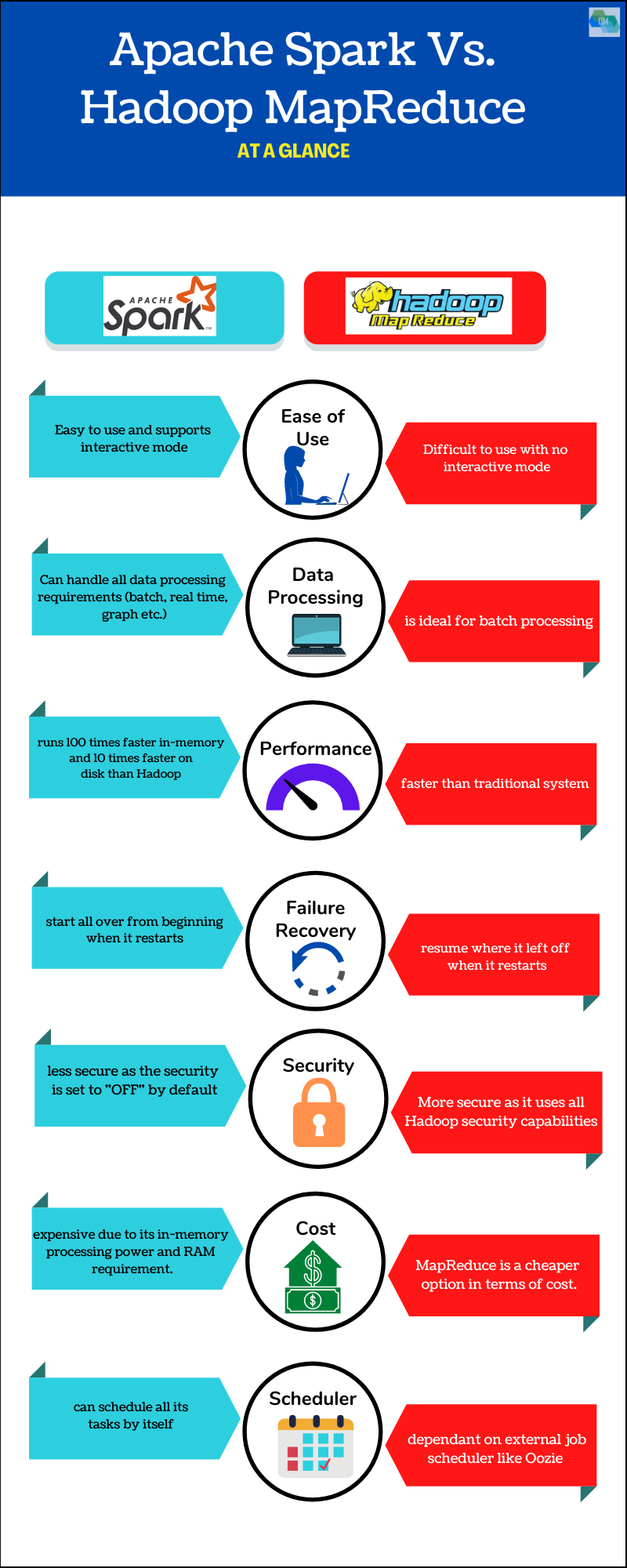This article was published as a part of the Data Science Blogathon.
Introduction
Apache Spark was released in 2014. Earlier to it, Hadoop MapReduce was the main focus for processing large data with no competitors. While Spark is the new and widely used technology, MapReduce still has its place in specific applications. Let’s take a deeper look at two popular tools for big data, MapReduce and Spark, and compare them to decide which is best in specific circumstances.
Organizations are receiving big data at an overwhelming pace due to smart devices and the increased use of internet technologies. Hence, it is necessary to handle it for efficient data analysis becomes crucial. While several technologies are used to easily process big data, two of the most popular are Hadoop MapReduce and Apache Spark.
What is Apache Spark?
Apache Spark is an open-source distributed system for handling Big Data workloads. It improves query processing performance on varying data sizes by using efficient query execution and in-memory caching.
What is Hadoop MapReduce?
MapReduce is a Java-based distributed computing programming model within the Hadoop framework. It is used to access large amounts of data in the Hadoop File System (HDFS). The Mapper and Reducer are two jobs performed in MapReduce programming. Mapper is responsible for sorting all the available data, while Reducer is in charge of aggregating it and turning it into smaller chunks.
Top 7 differences between Apache Spark and Hadoop MapReduce
Although both the tools handle big data, they are not the same. Let us explore the main differences between them based on their features.

1. Ease of Use
Apache Spark contains APIs for Scala, Java, and Python and Spark SQL for SQL users. Apache Spark offers basic building blocks that allow users to easily develop user-defined functions. You can use Apache Spark in interactive mode when running commands to get an instant response.
On the other hand, Hadoop MapReduce was developed in Java and is difficult to program. There is no interactive mode with Hadoop MapReduce, unlike Apache Spark. However, Hive provides a command-line interface. It is used for issuing commands in successive lines of text.
Spark is more user-friendly and features an interactive mode. On the other hand, Hadoop MapReduce is more difficult to program. However, there are other tools available for help.
2. Data Processing
Apache Spark can perform many other tasks than just data processing. Apache Spark can handle graphs and has its own Machine Learning Library – MLlib. Because of its great performance, Apache Spark can be used for both – batch and near real-time processing. Apache Spark is a flexible, multiple-use platform that can be used to handle all activities rather than dividing them over many platforms.
MapReduce is an ideal solution for batch processing in Hadoop. If you want a real-time solution, you can use Impala or Apache Storm, and for graph processing, you can use Apache Giraph. Earlier, MapReduce used Apache Mahout for Machine Learning tasks, but Mahout was discontinued when Spark came in.
Spark is great because it provides a single data framework for all your data processing requirements. Spark is capable of handling any data processing requirement. On the other hand, MapReduce is less flexible than Spark when it comes to performing a variety of data processing jobs, while MapReduce could be one of the best available batch processing tools.
3. Performance
Apache Spark is very much popular for its speed. It runs 100 times faster in memory and ten times faster on disk than Hadoop MapReduce since it processes data in memory (RAM). At the same time, Hadoop MapReduce has to persist data back to the disk after every Map or Reduce action.
Spark takes a lot of RAM to operate effectively. Spark saves processes to memory and keeps them there if different instructions are not given. If Spark is used with other resource-demanding services, its performance may be hampered notably. Additionally, Spark’s performance will suffer if the data sources are too large to fit fully in memory.
Although MapReduce does not provide data caching, other services can assist it with little to no performance downturn since it terminates its operations the moment they are complete.
MapReduce and Spark both have benefits when it comes to performance. Spark is easily the best choice for your big data requirements if your data get accommodated with the amount of memory space you have or if you have a dedicated cluster. On the other hand, MapReduce is a better solution if you have a large volume of data that won’t fit neatly into memory, and you need your data framework for coordinating with other services.
4. Failure Recovery
MapReduce is more suitable for recovery after failure than Spark since it uses hard drives instead of RAM. When Spark comes back online after crashing in the middle of a data processing activity, it will have to start all over from the beginning. This process requires more time.
If MapReduce fails while doing a job, it will resume where it left off when it restarts. Because MapReduce is based on a hard disk, it can maintain its position if it fails in the middle of a job.
Both Spark and Hadoop MapReduce have high failure tolerance, but Hadoop MapReduce is slightly more tolerant.
5. Security
Apache Spark’s security is set to “OFF” by default, leaving you vulnerable to threats. Spark supports RPC channel authentication through a shared secret. Event logging is a feature of Spark, and Web UIs can be protected using java extensions. Furthermore, because Spark can operate on YARN and use HDFS, it can benefit from Kerberos authentication, HDFS file permissions, and encryption between nodes.
Hadoop MapReduce can make use of all Hadoop security capabilities and can integrate with other Hadoop security projects like Knox Gateway and Apache Sentry. Spark security is still in its early stages compared to MapReduce, which has more security features and projects.
6. Cost
While Spark and MapReduce are open-source solutions, you will still need to spend more on computers and staff. Spark and MapReduce can both run on commodity systems and in the cloud.
MapReduce requires a larger number of devices with higher disk space but little RAM capacity. On the other hand, Spark requires fewer devices with standard disk space but definitely higher RAM capacity. An adequate capacity is necessary to hold all the available data. Because disk space is less expensive than RAM space, MapReduce is the less expensive alternative.
7. Scheduler
Apache Spark can schedule all its tasks by itself, while Hadoop MapReduce requires external schedulers like Oozie.
Conclusion
This article briefly explored the key differences between two popular big data frameworks – Apache Spark and Hadoop MapReduce.
Apache Spark’s capabilities for data scientists are amazing; still, a lot of improvement is possible for the tool’s growth. Despite being older and slower than Spark, MapReduce is still a popular choice for batch processing. MapReduce can also be used for dealing with large data sets that don’t fit in memory.
As discussed earlier, there are some notable benefits of MapReduce over Spark. You should select a framework that best matches your requirements. Spark is probably the better choice if you need to do a little bit of everything, while MapReduce is better if you require a batch processing engine that can handle big data.
The media shown in this article is not owned by Analytics Vidhya and is used at the Author’s discretion.




